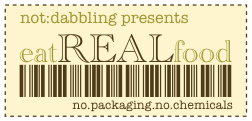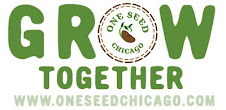I really need to find a way to make this blogging thing pay. It's taking up all my time. And the reason is: challenges.
Let’s Get Real! Food Challenge. Growing Challenge. Project GROW. And they all want their posts on Sundays.
So one challenge per post, and apologies for three posts (maybe four, also going to Chicago Flower and Garden Show) in one day. Current plan is an appropriate recipe for each one, but we'll see how I feel when I get to #3.
Let’s Get Real! is an incredible challenge, taken to its extreme. With the premise of minimizing packaging and food miles, in the three days since starting just the research (forget the actual eating), I have discovered that, despite living 50 miles south of the dairy heartland of America, most of the dairy products at the chain grocery stores come from places like California. (Can't buy the most ecologically correct brand, because I don't want to fund the on-going political career of the conservative wingnut who owns it.) They're just packaged in Wisconsin. WTF. No wonder my milk always tastes sour. It's been frozen and thawed and is already a week old by the time it gets on the shelf.
Forget flour. There is absolutely no way to tell where your flour comes from, and I'm sorry I'm just not going to mill my own. Which brings us to the main philosophical problem with trying to eat "real." Where does the balance tip the wrong way? I could drive about 20 miles, to where there's a year-round farmer's market. Or I could go to Whole Foods, where I'll pay around 5 times the regular brand price for the privilege of feeling smug and local. And frankly, I don't really trust the labels at Whole Foods. I think those brands play the same sorts of games that Dean's milk does, importing food to be packaged locally so that they can call it local.
FamilyFarmed is trying to find me locally milled flour that I don't have to order from the internet.
Then there's eating out.
I managed to locate just two restaurants where I can be reasonably sure that they source lots of their food locally, because they make it part of their branding. One is too expensive to pretty much ever eat there. The other is fine if the dinner is your destination, but last night my destination was the movies, and this restaurant is on the other side of town (and I live in a big town). We ate at the Golden Nugget. It was food. Not even going to think about how "real" it was.
UPDATE from Abby: Mado, Publican, Blackbird, Avec also source ingredients locally.
I'm sure once all these logistical issues are sorted out I will find that the food is better, but at this point I'm not sold on the concept, and it's not just about the inconvenience. It's about that tipping point. I live in the 4th largest metropolitan area in the U.S. Nothing we eat comes from here (unless it comes out of my own garden). The closest working farm is 20 miles away; the bulk of the local food market is 50 to 100 miles. Is it still local?
Which is more sustainable--walking to the local big chain to buy my groceries, or driving 20 miles to go to the year-round farmer's market (and even in summer the nearest farmer's market is 5 miles away).
And to top it all off, I ran out of the Mrs. Richardson's caramel syrup that I like to put in my (shade-grown, organic, free-trade, but, sadly, imported) coffee.
UPDATE: Caramel syrup
The first time I made this, the sugar recrystalized. So here's a method that keeps it smooth
1 c. brown sugar
1-2 T water
1 tsp white vinegar
1 tbsp. butter
1/2 c. cream
1 tbsp. cornstarch
Put the brown sugar in a heavy-bottom saucepan, adding just enough water to make it the consistency of wet sand. Turn on the heat to medium and add the vinegar. This will keep the sugar from recrystalizing. Boil for about 5 minutes, stirring constantly. Add the butter and continue to boil until the butter is completely melted. Dissolve the cornstarch in the cream, then add it to the sugar and bring it back to a boil. Cool several hours in refrigerator or overnight.
1 week ago









When I started going through everything we consume here I got discouraged. Then angry. Why the heck would I purchase kale from California when it should be in season here? Why is 90 percent of the organic foods in Whole Foods from California, 5 percent local hydroponic, and 5 percent imported from South America? I had to realize there are just some things I either won't purchase because it's not in season, do without, or limit some exceptions. My exceptions are Fair Trade coffee, chocolate, and a few other odds and ends. Around here even the Amish don't grow their own grain, so I suppose if I'm going to eat it the least I can do is make sure it's grown & processed in the US.
ReplyDeleteXan, there are other locally-sourced eateries around my parts....have you checked out Mado? Pretty serious about cooking from our foodshed. Lula goes pretty heavy on local stuff too....in general there are a lot of places on the northwest side popping up with a surprising amount of local ingredients. Publican, Blackbird, Avec and the other restaurants in that group surprise me with the amount of local stuff on the menu.
ReplyDeleteNice to meet you yesterday, thanks for the seeds! Abbie
Abbie, thanks for the tips. The trick is figuring out how to google that!
ReplyDeleteJen, I hear you. Working through these philosophical issues has me in a bit of my own whirliegig. Good news is, the caramel syrup was dead easy to make, and works just great in the coffee. So score one for Eat Real Food.
ReplyDeleteI know you lean more toward vegetarian, but Mom sent this info my way for you Yanks. =)
ReplyDeletehttp://www.sevensons.net/index.htm
Also check out http://www.eatwild.com/products/tennessee.html
ReplyDeleteI hear you. It can be a real pain in the beginning. Websites like localharvest.org can help locate outlets near you. I found a number of my closest resources by just talking to like-minded people in my area. Sometimes you find things where you don't expect them. Our best local "farm store" is actually the ice cream shop of a local dairy that has kept adding refrigerator cases of other farmers goods over time. Something I learned last month was to keep looking and just let the stress go.
ReplyDeleteAlso, I think that it is important to keep in mind all the factors involved and not just food miles. There is a huge benefit to your local economy by keeping food dollars local. You can better know how your food is raised/grown when it is local, and the immediacy of customers helps keep producers acutely aware of the qualities valued by their customers, such as grass-fed or organic. I also don't think the goal should necessarily be 100% local. I don't see anything wrong with trading with our global neighbors, especially for things we either don't produce or don't produce enough of to meet demand. Personally, I am shooting for an 80/20 local/non-local split.
Maggie, you hit the nail on the head. Ever since Oog figured out that he had seashells but no copper and Mook had copper but no seashells, people have been trading goods across vast distances. The key is balance, and thinking of sustainable living as non-greedy living. It is greedy for a Chicagoan to drink milk from California, bc we produce milk right here. It is not as greedy to drink coffee from Haiti, because that's where the coffee is.
ReplyDeleteEating local is even a challenge for those of us living in the country. We can get fair-trade coffee from Mexico, roasted in West Texas but shipped from Arizona, and citrus from South Texas, but any kind of organic grain is probably a nine hour drive one way!
ReplyDeleteAnother insidious practice is packaging--we bought some Texas onions a couple years ago but when we read the fine print discovered they were packaged in Florida! So, while they were likely grown in the the county south of us they had already done a lot of needless traveling. That's when we started growing our own onions.
As someone who lives in the rain belt of the Pacific Northwest I understand your frustration. We have lots of leafy greens year round and apple galore that are local but not a speck of grain can be found around here.
ReplyDeleteI do grind my own flour but the grain is from the other side of the mountains where there is actually sun, lol!
Good luck on your balancing act, Kim
A friend pointed out that sometimes you don't want to feed the local region, if, for instance, the virgin land was forest. Let the land go back to forest, and import your food. Just import it from family farmers instead of industrial farms.
ReplyDelete